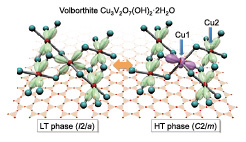Orbital Switching Transition in a Quasi-Kagomé Antiferromagnet Volborthite
Hiroi Group
Kagomé antiferromagnets have been extensively studied to search for exotic magnetic phenomena. It is believed that an unknown ground state, such as a spin-liquid, is realized instead of the conventional Néel order due to strong geometrical frustration for spins residing on the kagomé lattice. Several Cu minerals comprising kagome lattices made up of Cu2+ ions have been focused thus far as model compounds for the spin-1/2 kagome antiferromagnet: herbertsmithite ZnCu3(OH)6Cl2, volborthite Cu3V2O7(OH)2・2H2O, vesignieite BaCu3V2O8(OH)2, haydeeite Cu3Mg(OH)6Cl2, and kapellasite Cu3Zn(OH)6Cl2. However, the true ground state of the spin-1/2 kagome antiferromagnet remains still mystery because of some obstacles in real compounds: distortion, defects and other deviations from the ideal kagomé model tend to hinder the characterization of low-temperature magnetic properties.

Fig. 1. Orbital switching transition observed in a single crystal of volborthite. Parts of the kagomé layer of the HT phase (right) and the LT phase (left) are illustrated. In the HT phase, d3z2-r2 and dx2-y2 orbitals are selected for spins at the Cu1 and Cu2 sites, respectively. In contrast, dx2-y2 orbitals are selected at all the Cu sites in the LT phase, indicating that orbital switching takes place at the Cu1 site.
Volborthite is a mineral found in nature as yellow-green crystals of sub-millimeter size. A decade ago, the compound was first studied in terms of kagomé physics [1]. Recently, a high-quality powder sample of volborthite was synthesized in a hydrothermal condition and found to exhibit anomalous magnetic transitions at very low temperatures around 1 K and also under high magnetic fields [2, 3]. The compound crystallizes in a monoclinic structure with space group C2/m (Fig. 1). The kagomé layer consists of edge-sharing CuO6 octahedra and is separated by non-magnetic V2O7 pillars and water of crystallization. There are two crystallographic sites for Cu; the Cu1 and Cu2 atoms are arranged in isosceles triangles with approximately 3% distortion, which are connected to each other to form a slightly distorted kagomé plane. It is obvious from the deformations of the CuO6 octahedra that the unpaired electrons on Cu1 and Cu2 occupy d3z2-r2 and dx2-y2 orbitals, respectively.
Very recently, we found a unique structural transition at around room temperature that shows "switching" from one d orbital to another upon cooling in a synthetic single crystal of volborthite [4]. The transition causes a large change in the coordination environment of the Cu1 site: the Cu1O6 octahedron takes two short Cu-O bonds and four long bonds in the high-temperature (HT) phase (space group C2/m), while two long and four short bonds in the low-temperature (LT) phase (I2/a). This means that the dx2-y2 orbital must be selected in the LT phase, instead of the d3z2-r2 orbital in the HT phase. On the other hand, there is little change in the coordination of Cu2 with the spin-carrying orbital unchanged.
The change in the orbital state found in volborthite should be distinguished from the phenomenon known as orbital ordering. In general, orbital order occurs in systems where the symmetry of the coordination polyhedra is high, leading to orbital degeneracy and thus an orbitally disordered ground state. This symmetry may be broken, and a unique orbital configuration is selected by a cooperative Jahn-Teller distortion at lower temperatures, as observed in NaNiO2 (Ni3+, d7). This is an order-disorder transition associated with the orbital degree of freedom. In contrast, because of the strong Jahn-Teller effect of the Cu2+ ion, no corresponding orbital disordered state has been observed in any copper compounds even at high temperature; most compounds decompose before orbital disordering. Therefore, the change in the orbital state in volborthite is not orbital order, but could be called orbital switching.
Because magnetic interactions between Cu spins in the kagomé lattice are seriously modified by the orbital switching, magnetic properties of the compound change dramatically. Magnetic long-range order occurs through two successive phase transitions at around 1 K in single crystals, which differs from the previously reported LT behavior of polycrystalline samples. Detailed investigations are now in progress.
References
- [1] Z. Hiroi, N. Kobayashi, M. Hanawa, M. Nohara, H. Takagi, Y. Kato, and M. Takigawa, J. Phys. Soc. Jpn. 70, 3377 (2001).
- [2] H. Yoshida, Y. Okamoto, T. Tayama, T. Sakakibara, M. Tokunaga, A. Matsuo, Y. Narumi, K. Kindo, M. Yoshida, M. Takigawa, and Z. Hiroi, J. Phys. Soc. Jpn. 78, 043704 (2009).
- [3] M. Yoshida, M. Takigawa, H. Yoshida, Y. Okamoto, and Z. Hiroi, Phys. Rev. Lett. 103, 077207 (2009).
- [4] H. Yoshida, J. Yamaura, M. Isobe, Y. Okamoto, G. J. Nilsen, and Z. Hiroi, Nat. Commun. 3, 860 (2012).
